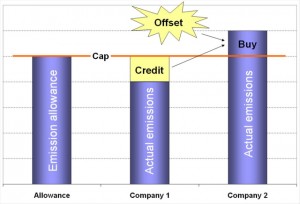There are basically two ways to put a more appropriate price on carbon: carbon tax or by implementing a cap and trade system.
On this page, you will find the following topics related to carbon cap & trade systems:
- How it works
- Past success
- Carbon trading
- Issues
- Over-reliance
- Cap set too low
- Intensity-based caps
- Overhead
Click a link in the list above to jump to that topic on this page.
Cap & Trade is intended to provide a mechanism to encourage emitters of large amounts of greenhouse gas (GHG) to invest in changes that will reduce their emissions. It can also provide a means to transfer some wealth and sustainability to developing nations by means such as the Clean Development Mechanism (CDM).
How it works
In a Cap & Trade system, large emitter companies will be allowed to produce no more than a set amount of GHG emissions – a cap. The cap will be different for different industrial sectors and the cap must be reduced on a schedule so that overall emissions continually decrease. (1)
See Figure 1 – At the end of each year, large emitter companies will report their emissions. They will then take action depending upon the level of those emissions relative to the cap:
- Company 1 – Their actual emissions are less than the cap. Therefore, the amount of emissions less than the cap earns them permit credits that they can sell or trade.
- Company 2 – Their emissions are more than the cap. So, they will need to either buy regulated emitters’ credits (such as those held by Company 1) or carbon offset credits. This means they get involved in carbon trading.
Carbon trading
The only way to prevent the continued increase in global average temperatures is by reducing our greenhouse gas (GHG) emissions. The most important way to achieve this GHG reduction is directly by changing our behaviour, technology, systems, and infrastructure so that we emit less GHG every day.
The second way to achieve GHG reduction is indirectly through carbon trading. You can learn more about carbon trading on these sub-pages:
![]() Click a topic to jump to a page with details.
Click a topic to jump to a page with details.
Carbon trading alone can’t achieve the GHG emissions reduction we need. But carbon trading could play a valuable role as long as we keep it in perspective and fit it into a much broader, more intense, and complete system.
Past success
Cap & Trade has been valuable in the past.
- In the 1980s, it was first used in the US to reduce acid rain.
- After 1990, Cap & Trade got global industry to dramatically and quickly reduce the production of ozone-depleting chemicals to shrink the “hole in the ozone”.
Issues
We need to be conscious of a number of factors that can reduce the effectiveness of Cap & Trade:
- over-reliance
- caps set too low
- intensity-based caps
- overhead
Over-reliance
The ozone problem (See Past success above) involved a relatively limited number of companies dealing with manufacturing specific chemicals. Greenhouse gases are much more pervasive, come from many more sources, and reducing them is much more complicated. The truth is, Cap & Trade, emission offsetting, and carbon sequestration can’t achieve our goal alone.
The real danger is over-reliance on any of these. If we treat them as “magic bullets” and let “them” do it for us, we will delay the emission reductions that each and every one of us must make. We need to massively reduce our greenhouse gas (GHG) emissions right now.
This means it’s up to all of us to change our behaviour.
Caps set too low
Emission cap levels are often set lower than the targets that science prescribes to bring about meaningful reduction in GHG emissions. (2)
There is a strong case that we don’t just need to stop increasing CO2 in the atmosphere. We really need to reduce the concentration of CO2 to 350 parts per million. (4) (Its about 400 now.)
Emissions caps are set by governments who are under pressure from industry who don’t want their costs increased and who fear that customers (voters) will be upset with price increases.
Intensity-based caps
There is a danger that intensity-based caps will allow overall GHG emissions to increase. Intensity-based caps do not limit absolute emissions levels but are calculated based on emissions per unit of fossil fuel used. (4)
Therefore, it is possible for a large emitter to increase their overall emissions and stay under the cap as long as their emissions per unit of production decrease.
Overhead
All of this validation and verification of carbon credits costs money – thousands per project. So, it is often impractical on a smaller scale. (e.g. municipalities with small landfills or individual farmers)





